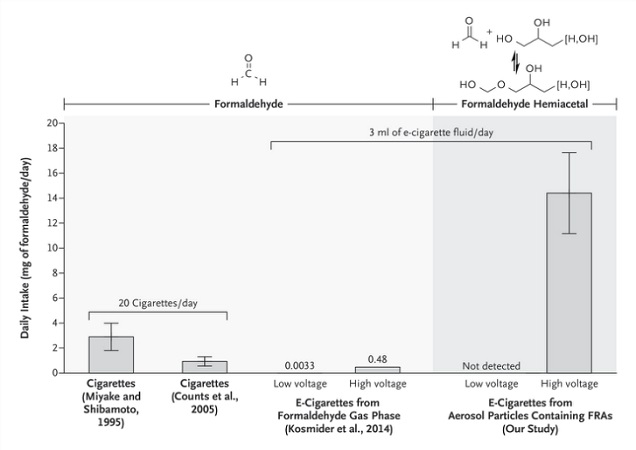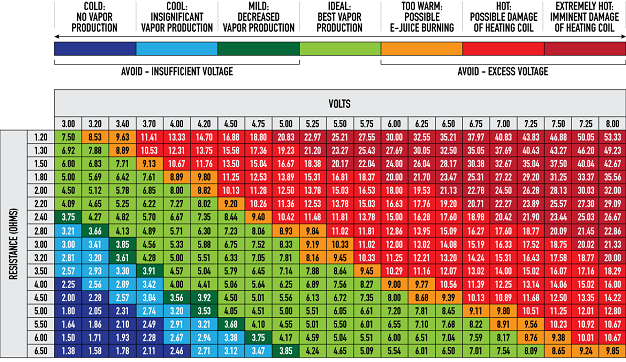
The cancer risk associated with formaldehyde consumption from long-term high-voltage vaping is 5 to 15 times greater than the formaldehyde-related risk from long-term pack-a-day smoking, according to a new study published as a letter in the New England Journal of Medicine. Cue the scary headlines: “Before you vape: High levels of formaldehyde hidden in e-cigs.” So, what is it that’s got the media so worked up? You may recognize this finding as effectively identical to a study from Japan and a study on high-voltage vaping and formaldehyde production from last year, and you’d be quite right to assume, just like in both of these pieces of research, there’s more going on here than it would initially seem.
Summary
- The researchers tested an atomizer of unstated resistance at 3.3 and 5 V, looking for formaldehyde hemiacetals in the vapor.
- At lower voltages, the hemiacetals were undetected, but at 5 V there were a lot more of them.
- The formaldehyde hemiacetals were classed as “formaldehyde-releasing agents” (with no relevant evidence provided as to why), and were assumed to be as carcinogenic as formaldehyde itself, even though there's no evidence they're toxic or carcinogenic.
- Based on these assumptions, the lifetime cancer risk (from formaldehyde alone) for a long-term vaper was estimated to be 5 to 15 times that of a smoker.
- In an email, the authors confirmed that they used a top-coil clearomizer, with a resistance of 2.1 ohms. At the higher voltage, this means around 12 watts was going to the atomizer. Following the puffing schedule used with this would invariably lead to dry puffs.
- Therefore, the increased risk observed in this study is based on faulty assumptions applied to highly unrealistic vaping conditions, and even then it only addresses a single chemical from the 70 or so carcinogens in cigarette smoke.
The Study: Hidden Formaldehyde in E-Cig Aerosols
The original article can be read in full, for free, and the problems with the news reporting of the story start as soon as you make it to the second sentence. I know reading is such a pain in the ass for journalists, but if any had actually made it to the second sentence, they would have read that the researchers didn’t measure formaldehyde levels at all, but levels of formaldehyde-containing hemiacetals. As Dr. Farsalinos explains, these hemiacetals are combinations of formaldehyde with alcohols (namely, the PG and VG in e-liquid), which the authors characterize as “formaldehyde-releasing agents.” Sadly, the reference they provided about formaldehyde-releasing agents (investigating contact allergies from them) has no bearing on e-cigarettes, because these agents are not the hemiacetals found in e-cig vapor.
So we’ve really stumbled at the first hurdle here. Dr. Farsalinos points out that there is no evidence that these hemiacetals are carcinogenic or toxic, and even suggests that they could protect against the potential (and likely very small) risk associated with formaldehyde from e-cigs (produced from the heating of PG). But, with that (crucial) caveat in mind, let’s see what they actually did.
The study involved producing vapor from a VV e-cigarette and analyzing it using nuclear magnetic resonance spectroscopy. They used a “tank system” e-cigarette, but no information was provided as to the model or other even more crucial factors. The vapor was produced by ten puffs over the course of five minutes, using 3 to 4 second puffs, and the tests were conducted at both 3.3 and 5.0 V.
At the lower voltage, the researchers didn’t detect any formaldehyde hemiacetals, meaning there was less than 0.1 millionths of a gram (μg) released in the ten puffs. When the e-cig was cranked up to 5 V, however, the production increased notably, reaching 380 μg per ten puffs.
Are Vapers More at Risk from Formaldehyde than Smokers?

The researchers then proceeded to make several estimates based on the high voltage figures. For a vaper consuming 3 ml of e-liquid per day, the estimated formaldehyde hemiacetal exposure would be around 14.4 mg per day, and the authors claim this estimate is conservative because they didn’t collect all of the vaped liquid or look for gaseous formaldehyde. By way of comparison, the formaldehyde delivery from one cigarette is about 150 μg, and from a pack of 20 you’d get about 3 mg.
To estimate the resulting cancer risk, the researchers used the known cancer risk levels for formaldehyde and these figures. For somebody (70 kg or 154 pounds in body weight) who smokes a pack of cigarettes per day, the lifetime risk of cancer from formaldehyde exposure is around 9/10000 or 0.0009 (with 1 corresponding to certainty and 0 being no risk at all). Based on the assumption that inhaling formaldehyde hemiacetals (called “formaldehyde-releasing agents” in the absence of any reason to think they actually are) carries the same cancer risk as formaldehyde (despite there being no evidence of any risk), the authors calculate a formaldehyde-related cancer risk for a long term vaper of 42/10000 or 0.0042. This is between 5 and 15 times higher than from smoking (depending on which estimate for smoking is used).
So there is quite a lot to unpack here. Firstly, it’s clear that the cancer risk from formaldehyde – even if we dumbly accept all of the authors’ methods and assumptions as valid – is pretty tiny. It’s saying that for 10,000 long-term vapers, formaldehyde would cause cancer in 42 of them (0.42 percent). And of course, there are dozens of carcinogens in tobacco smoke, so even if the risk for one of them from vaping was much larger than the risk from smoking, switching to vaping would still represent a drastic reduction in risk.
The bigger problems come from the method. As you may have noticed, they did not specify the resistance of the atomizer, which is crucial information for working out how much power was going to the coil and the likely temperature it was reaching. However, a Reddit poster received an email from the researcher confirming that a 2.1 ohm, top coil clearomizer was used. Based on this, the resulting wattage at the higher voltage – the only time when the formaldehyde hemiacetals were detectably produced – was around 12 W.
For most atomizers – outside of rebuildables – 12 W is a very high power that would clearly result in a high temperature (thus increasing the conversion of PG into formaldehyde and the production of formaldehyde hemiacetals), and more importantly, eye-watering dry puffs.

You can test this out for yourself; get a top-coil clearomizer and vape at 12 W or so for 5 minutes, using 4 second puffs with 30 seconds between each. It’s immediately obvious that you wouldn’t keep vaping from it (good luck if you’re trying to go for five minutes!). This is what you’d have to do all of the time to experience the risk the researchers calculated.
And after all this, we still have to account for the most crucial, conclusion-invalidating fact: we are not talking about formaldehyde production here! We’re talking about the formaldehyde hemiacetals produced, which are not known to be carcinogenic or toxic, and which the authors provide no valid justification for calling “formaldehyde-releasers.”
Conclusion – What’s the Bottom Line? What Did They Really Find?
Putting it all together, the study says that if you vape like an absolute moron with no tastebuds, all the time, then you’ll be exposed to some chemicals that we have no evidence of risk from. Then, if you imagine that those chemicals are as dangerous as formaldehyde (for no other reason than formaldehyde being a component of them), you’ll be at more risk of cancer from formaldehyde inhalation than a cigarette smoker is. Of course, you’ll also have to forget that the cancer risk from formaldehyde alone, even for a smoker, is pretty low, and it’s probably the multitude of other carcinogens in cigarette smoke you should be worried about.
So this study joins the slush-pile of other garbage research with similar conclusions, all hinging on the basic fact that the higher the temperature, the more chemistry stuff happens. If you increase the temperature to unrealistic levels, you’ll get unrealistic chemical production. If only there’d been a simple and cheap way the researchers could have protected against this, like, I don’t know, hiring a vaper to test the vaping schedule out, testing it themselves, or just reading the abundant information online about dry puffs. And more importantly for the public opinion of e-cigs, if only journalists could actually read studies and research anything they don’t understand, instead of parroting bullshit like brainless sock puppets.

